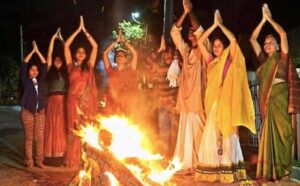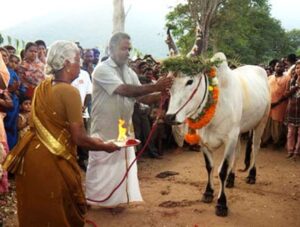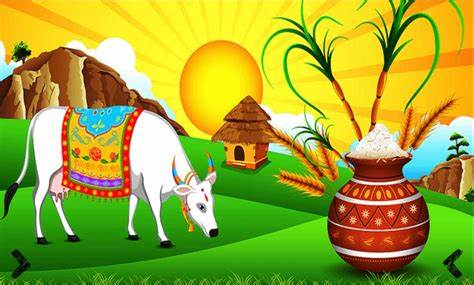The whole of Bharata is bedecking to celebrate Makarasankranti, the festival of harvest, marking the end of winter followed by a long series of seasonal Indic festivals celebrating the divinity in nature. The day marks an important transition of the Sun to Makara, which spiritually also assumes special significance.
Remember the scene from the Mahabharata war. Bheeshama who lay on a bed of arrows waited till the arrival of Uttarayana to give up his life, a vow he had taken.
The day marks the beginning of Uttarayana considered auspicious for all celebrations in the society. Various shastras mention how performing rituals like Upanayana, gifting of cows, and marriages are to be performed in Uttarayana.
The very word Sankranti signifies the transitioning of the Sun from one Rashi to another (Zodiac).
There are twelve different Sankranti in a year. Meshasankranti, Vrushabhasankranti, Mithunasankranti, Kataka (Karkataka) Sankranti, Simhasankranti, Kanyaasankranti, Tulaasankranti, Vruschikasankranti, Dhanusankranti, Makarasankranti, Kumbha and Meenasankranti.
Out of these, the most popular one is Makarasankranti.On Dec 22nd, the solstice happens, this means, in relation to the sun, the tilt of the planet happens. From this day onwards, the northern movement of the sun gets stronger. However, the transitioning of the sun from one Rashi to another happens under one-thousandth of a Truti (Truti=1/1687.5th of a second).
This transition is not possible to be sensed by ordinary human beings but a yogi with the right sadhana can sense it. Therefore, it is suggested to perform righteous deeds before and after this celestial event.
As the day assumes special significance from a spiritual point of view, it has long been held to take a dip in holy rivers. The day is also quite right for japa, tapa, homa, and tarpana for pitru. The day also happens to be the right day for those sadhakas to be initiated with the mantra deeksha.
Sesame seeds assume a lot of importance on this day. Taking bath using sesame seeds with cold water, giving tarpana through black sesame seeds, mixing sesame seeds with jaggery, dry coconut pieces and chana, the same are distributed.
In the southern states of India, the whole of dhanur masa (December)which precedes this is celebrated with Pongal, the preparation with rice and moong dal offered daily. Sankranti marks the culmination of this celebration with an exclusive preparation of Pongal.
The overflowing of the Pongal from the hot vessel symbolises the outpouring of the ecstatic feeling of a realised soul.

The day before Sankranti is celebrated as Bogi (the festival is for both yogi and bhogi!). On this day, people discard old and derelict things and light up a bonfire with logs of wood symbolising the mark of the new year.

The day after Sankranti is celebrated as a Kanu festival in parts of Tamil Nadu. The food remains from the day are mixed with Kumkum, haldi, fruits, and pieces of sugar cane and offered to birds and bhoota by sisters for the well-being of brothers.

The day of Sankranti is celebrated with special decorations of the Cows and passing them over the fire, a practice still followed in rural parts.
The two horns of a Cow symbolise the Uttarayana and Dakshinayana. The Cow represents the union or Sandhi and thus the worship of the cow is considered very auspicious on this day.

From Bhagavat Geetha, Upanishads and Itihasas declare Uttarayana as the period when one departs from their earthly life for liberation.
The harvest festival as popularly known has a deep spiritual connotation combined with the festivities marks a true celebration of cosmic system and nature.
NOTE: All pictures, including featured image sourced from internet
Kindly donate to Bharat Voice at https://rzp.io/l/5HCr6XZNU
![]()
- Ugadi the dawn of a new beginning - March 22, 2023
- The legendary life of master story teller-Dr SL Bhyrappa - January 27, 2023
- Dr. Shankar Rajaraman: The mind healer turned mind stimulator - January 25, 2023

